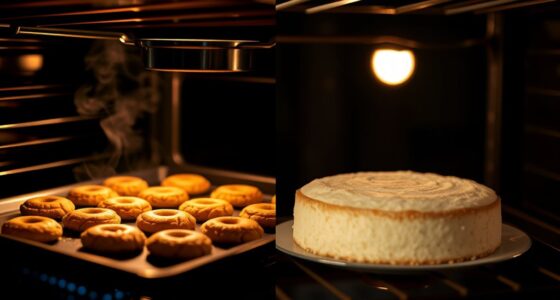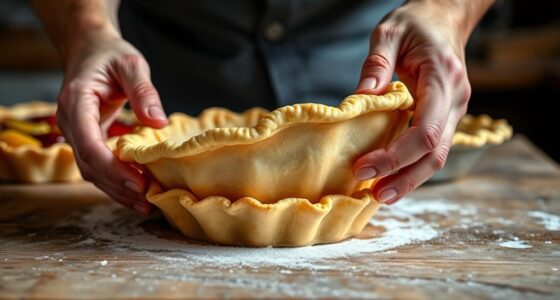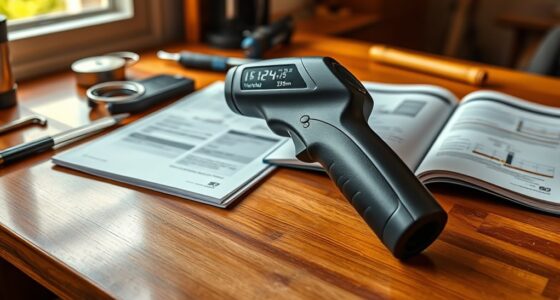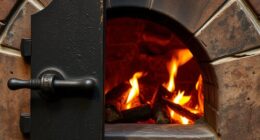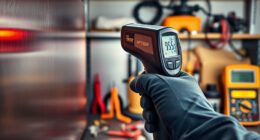Understanding high heat versus low heat in baking helps you control texture and doneness. High heat, usually above 400°F, promotes browning and crust formation quickly, while low heat allows gentle, even cooking for delicate items. Using the right temperature depends on what you’re baking and the desired outcome. Mastering these differences guarantees your baked goods turn out just right. Keep exploring to learn how to adjust temperatures effectively for perfect results every time.
Key Takeaways
- High heat (around 400°F+) promotes browning, crust formation, and quick cooking; low heat offers gentle, even baking for delicate items.
- Use high heat for crisp textures and rapid browning, while low heat prevents burning and ensures thorough doneness.
- Proper oven calibration and tools like thermometers are essential for accurately applying high or low heat.
- High heat requires careful timing to avoid overbaking or burning, whereas low heat helps retain moisture and develop flavors.
- Adjust baking times based on heat level, preheat thoroughly, and monitor temperature for optimal results.
Understanding Temperature Settings in Baking
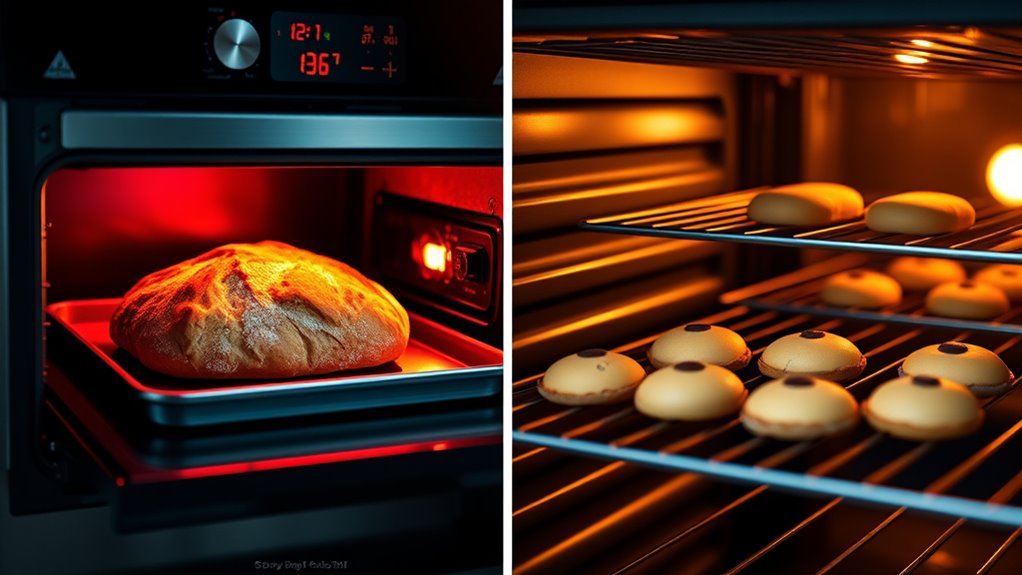
Understanding temperature settings in baking is essential because they directly influence the outcome of your baked goods. When you choose the right oven temperature, you ensure even cooking and proper texture. Using the correct baking equipment, like a reliable oven thermometer, helps you maintain accurate temperatures. Always prioritize oven safety by avoiding overheating, which can cause burns or fires, and by keeping your oven clean. Properly calibrated ovens prevent uneven heat distribution, which can ruin delicate baked items. Remember, high temperatures are often used for quick baking or browning, while low heat is better for slow, even cooking. Knowing how to set and control your oven’s temperature is the foundation for successful baking every time.
What Does “High Heat” Really Mean?
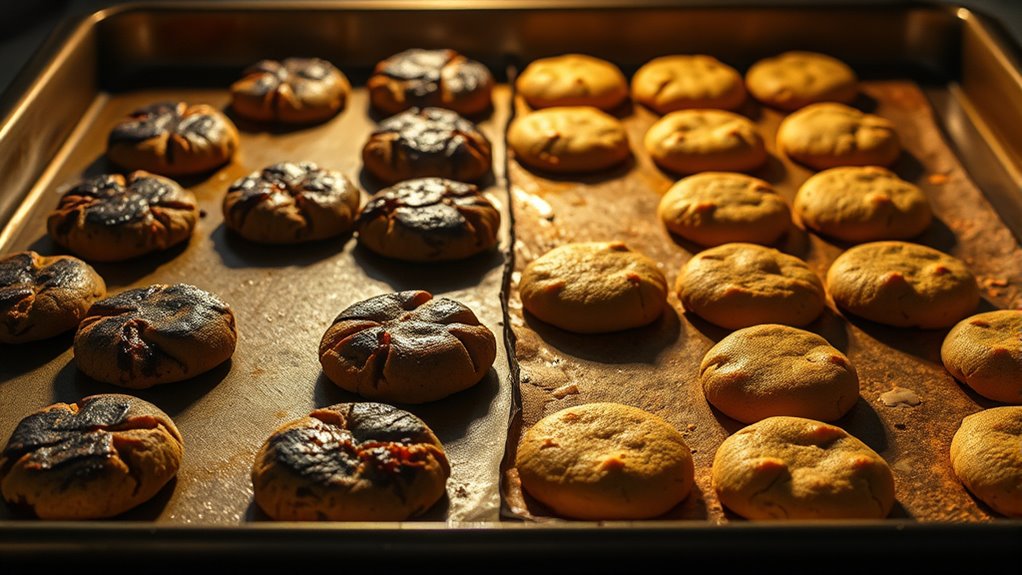
When a recipe calls for “high heat,” it generally means setting your oven or stovetop to a temperature around 400°F (200°C) or higher. This temperature range is essential for achieving a crisp crust or browning, especially in baking bread or roasting vegetables. However, high heat also requires careful attention to oven safety—avoid overheating or uneven heating that can cause burns or damage your bakeware. The materials of your bakeware matter; metal pans like aluminum or cast iron handle high temperatures well, while glass or ceramic may need adjustments to prevent cracking. Always monitor your oven’s temperature accuracy and ensure proper ventilation. Using the right bakeware materials helps you safely and effectively reach the high heat needed for those perfect results. Additionally, understanding the Textile Line can help you select appropriate tools and materials for your baking setup, ensuring durability and safety.
The Role of “Low Heat” in Baking Processes

While high heat helps achieve a perfectly browned crust or seared exterior, low heat plays an equally important role in gentle, even cooking. It allows baked goods to cook through without burning or over-browning, especially for delicate items like custards or bread. Using low heat also promotes oven safety by preventing overheating and reducing the risk of accidents. Proper baking equipment, such as thermostats and heat diffusers, ensures consistent low temperatures. Understanding the role of low heat helps you avoid undercooked centers or burnt edges. Additionally, controlling the contrast ratio in your oven settings can enhance uniform heat distribution for better results.
Common Baking Techniques Using Different Heat Levels
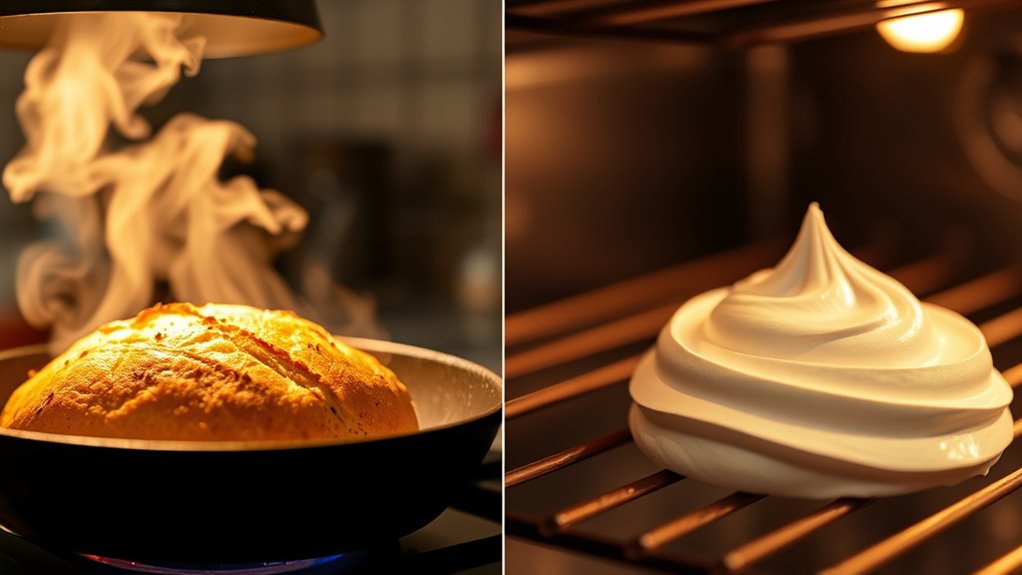
Different heat levels serve distinct purposes in baking, and mastering their use can considerably improve your results. High heat quickly browns and forms a crust, ideal for roasting vegetables or creating crispy exteriors. Low heat allows gentle cooking, perfect for delicate ingredients or slow roasting to prevent over-browning. Accurate oven calibration ensures consistent temperatures, which is vital for predictable ingredient interactions. For instance, using high heat for bread crust development requires precise timing to avoid burning, while low heat helps melt cheese evenly without overcooking the toppings. Understanding these techniques helps you control moisture retention, texture, and flavor development. Utilizing digital thermometers and adjusting heat levels based on your recipe and oven calibration prevents surprises, ensuring your baked goods turn out perfect every time.
Tips for Adjusting Heat for Perfect Baking Outcomes

Adjusting the oven temperature accurately is key to achieving consistent baking results. To do this effectively, consider these tips:
- Monitor ingredient temperature to ensure ingredients are at the right stage before baking, which influences how heat affects the final product.
- Use an oven thermometer to verify your oven’s actual temperature, promoting oven safety and preventing over- or under-baking.
- Adjust baking time based on your oven’s heat, increasing time for lower temps or reducing it for higher temps.
- Preheat thoroughly to avoid uneven heat distribution, which can compromise oven safety and result in inconsistent outcomes.
- Familiarize yourself with different heat levels by exploring best beaches, as understanding how varying environments respond to heat can enhance your baking precision.
Frequently Asked Questions
How Does Altitude Affect High and Low Heat Baking?
Altitude affects both high and low heat baking by requiring adjustments to maintain baking consistency. At higher altitudes, your recipes might need more liquid, less baking powder, or longer baking times to prevent over-expansion or dry textures. These altitude adjustments guarantee your baked goods turn out well, whether you’re using high heat for crusts or low heat for gentle cooking. Always tweak your recipes to achieve the best results at different elevations.
Can You Mix High and Low Heat Methods in One Recipe?
Yes, you can mix high and low heat methods in one recipe. By layering different temperatures, you allow for better flavor development and control over texture. For example, starting with high heat helps brown or sear, then lowering the temperature ensures thorough cooking without burning. This technique gives you more precise mastery over your dish, balancing the benefits of both methods for ideal results.
What Are the Best Oven Tools for Precise Temperature Control?
You should use precision thermometers to monitor your oven’s temperature accurately. These tools give you real-time readings, helping you maintain consistent heat. Additionally, regularly calibrate your oven to guarantee it reaches and stays at the set temperature. Investing in an oven thermometer and performing calibration checks will give you precise temperature control, so your baked goods turn out perfect every time, whether you’re using high or low heat methods.
How Does Baking Time Change With Different Heat Levels?
Baking time adjusts based on heat level impacts; higher heat usually shortens baking time, while lower heat extends it. When you increase the oven temperature, keep a close eye on your baked goods to prevent overbaking. Conversely, lower temperatures might require extra time to achieve the right doneness. Always check for visual cues and use a timer, as different recipes respond uniquely to heat level adjustments for ideal results.
Are There Specific Ingredients Best Suited for High or Low Heat?
Imagine ingredients as dancers, each with their own rhythm—some thrive in high heat, others flourish in low. You’ll find that ingredients like nuts and caramel benefit from high heat for rapid flavor development, while delicate items like soufflés or custards prefer low heat to prevent burning or overcooking. Selecting the right heat level guarantees ingredient compatibility and enhances flavor development, making your baked goods perfectly textured and delicious every time.
Conclusion
Mastering high heat and low heat baking means mastering your craft. It’s about knowing when to turn up the heat and when to turn it down. It’s about understanding the balance between quick crispness and slow, even cooking. It’s about embracing the art of control and the science of temperature. When you master these, you don’t just bake; you create perfection, every time. So, keep experimenting, keep learning, and keep baking with confidence.


